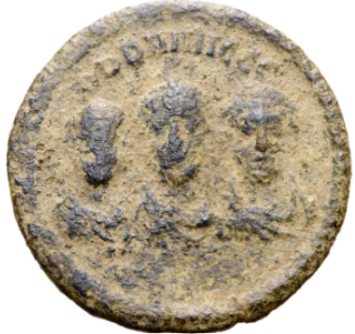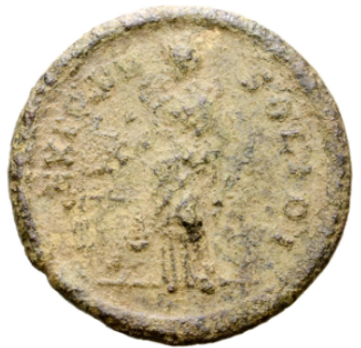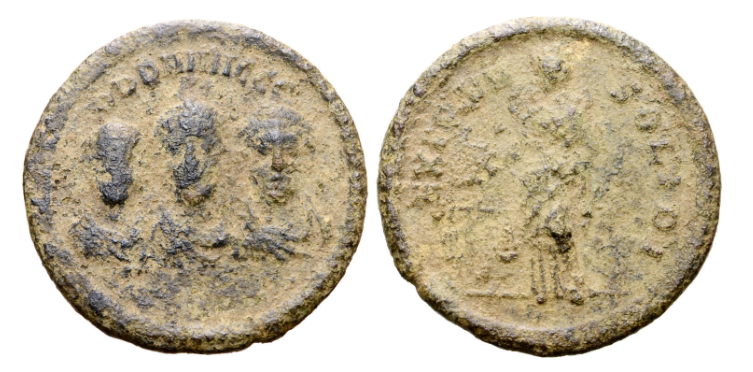
-
Copyright credit: Roma Numismatics Ltd

-
Copyright credit: Roma Numismatics Ltd

-
Copyright credit: Roma Numismatics Ltd

ARCHAEOLOGICAL DESCRIPTION OF THE WEIGHT
Authority
Arcadius, Roman Emperor
;
Honorius, Roman Emperor
;
Theodosius II, Roman Emperor
;
Theodosius I, Roman Emperor
Mint
Rome
Denomination
1 Nomisma = 1 Solidus
Material
Copper alloy (bronze or brass)
Manufacture
Struck
Shape
Disc or similar (ellipse, etc.)
Length
2.10 cm
Width
2.10 cm
Height
- cm
Metrology
| Mass (g) | Mass (grain) | Date of measurement | Reference | fragmented | cleaned | reference weight |
|---|---|---|---|---|---|---|
| 3.88 | - | - | Auction Roma 2020 | No | No | Yes |
Iconography
| Symbol | Technique | Direction | Position | Number | Synecdoche |
|---|---|---|---|---|---|
| Roman Emperor | Stamped / Countermarked / Struck | FACING | Three | Bust | |
| Aequitas / Justitia / Moneta | Stamped / Countermarked / Struck | LEFT | Standing | One | |
| Roma | Stamped / Countermarked / Struck | LEFT | Standing | One | |
| Balance scale | Stamped / Countermarked / Struck | One | |||
| Rotulus | Stamped / Countermarked / Struck | One |
Wear
Corrosion
Handle
No
Suspension hole
No
Recarved mould
No
Recarved weight
No
Intentionally destroyed
No
Archaeological description
Auction Roma 2020: Lot 1434. Theodosius I, with Arcadius and Honorius, Æ Exagium Solidi Weight. Constantinople, AD 402-408. DDD NNN GGG, diademed and draped facing busts of Honorius, Theodosius, and Arcadius respectively / EXAGIVM SOLIDI, Moneta standing to left, holding scales and cornucopiae; wreath between palm branches in exergue. Bendall, Byzantine Weights 8; Sabatier 7; cf. Göbl, Antike 228-9; RIC X, p. 8. 3.88g, 21mm, 11h. Near Very Fine; heavy encrustation. Extremely Rare; unaltered by piercing or plugging. From the inventory of a UK dealer. Official solidus weights, based on a standard 'imperial pound', came into being with the law of Julian of AD 363, which established a zygostates - an official weigher of solidi in each city - to restore confidence in the solidus, which had become subject to widespread clipping. Exagium derives from the Latin exigere, "to drive out" - in this case, the underweight solidi, thereby maintaining an acceptable weight standard necessary for the imperial gold coinage to circulate at full value. Many such exagia display holes and/or plugs to bring the exagium to the correct weight, so unmodified exagia (especially examples that are underweight such as the present piece) are thus a rarity.
Asolati 2022: Exagia solidi imperiali con indicazione esplicita della funzione: Arcadio, Onorio e Teodosio II, 403–408 d.C., exagium solidi. Zecca non indicata: Roma (?). D/ DDD NNN GGG; tre busti frontali, affiancati, diademati, drappeggiati e corazzati: quello a s. di dimensioni minori. R/ EXAGIVM SOLIDI; Roma come Moneta/Aequitas/Iustitia, turrita, stante a s. con bilancia e rotolo. f. Roma, E-Sale 77 (26/11/2020), lotto n. 1434: g 3,88; mm 21; h 11.
Asolati 2022: Exagia solidi imperiali con indicazione esplicita della funzione: Arcadio, Onorio e Teodosio II, 403–408 d.C., exagium solidi. Zecca non indicata: Roma (?). D/ DDD NNN GGG; tre busti frontali, affiancati, diademati, drappeggiati e corazzati: quello a s. di dimensioni minori. R/ EXAGIVM SOLIDI; Roma come Moneta/Aequitas/Iustitia, turrita, stante a s. con bilancia e rotolo. f. Roma, E-Sale 77 (26/11/2020), lotto n. 1434: g 3,88; mm 21; h 11.
Autopsy
No
INSCRIPTION
| Language | Technique | Legend type |
|---|---|---|
| Latin | Stamped / Countermarked / Struck | Authority, Denomination, Legal status |
Fac simile
[DD]DNNNGGG
[EXAGIVM SOLIDI]
Edition
D[(ominorum)] N(ostrorum) (Au)g(ustorum). || [Exagium solidi].
Monogram
ARCHAEOLOGICAL CONTEXT
Findspot (region)
Findspot (site)
context
CIRCUMSTANCES OF ACQUISITION
Region
City
Date of first acquisition
Nov. 26, 2020
circumstances
Antiquities trade.
DATING OF THE WEIGHT
Curatorial Section
LATE ROMAN AND BYZANTINE
Time frame
FROM
402
TO
408
Comments on Chronology
Auction Roma 2020: proposes a production date between 402 and 408.
Asolati 2022: suggests a chronological range from 403 to 408.
Asolati 2022: suggests a chronological range from 403 to 408.
COLLECTION HISTORY
Collection
| Name | Date of acquisition | Inventory number |
|---|---|---|
| Antiquities Trade | Nov. 26, 2020 | None |
Bibliography
| Reference | Page/Column | Reference (number) | Plate / Figure | Comment |
|---|---|---|---|---|
| Auction Roma 2020i | None | 1434 | fig. | None |
| Asolati 2022 | 260 | 11f | None | None |
VARIA
Additional comment
Asolati 2022: cf. Bendall 1996, –; Entwistle 2001, p. 264, n. III.70.
Permalink
External link